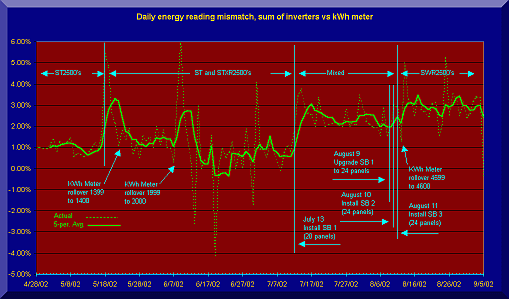The output of our PV plant is metered by a single
kilowatt-hour meter which is considered the standard reference. The
summation of the inverter indications is continuously compared to this
meter. The chart below reveals an interesting phenomenon.

This chart's time scale covers four phases of a 4-1/2 month period.
First there were three ST2500 and one ST2000 inverters, then the ST2000
and three STXR2500. When inverter comparison began there was a
period when one of the Xantrex inverters was replaced with a Sunny Boy,
and finally the current configuration in which all of the Xantrex
inverters were replaced by three Sunny Boys.
The chart shows the deviation between the system reference
kilowatt-hour meter and the summation of values reported by the inverters.
During the first phase, the inverter-reported values
agreed closely with the reference meter. This agreement scattered
noticeably as ST2500's were replaced with STXR2500's, however the mean
error was not far from zero.
However as the Xantrex inverters were replaced with Sunny Boy
inverters, the error makes a clear positive excursion.
From this it can be concluded that in my installation the Sunny Boy inverters report
optimistic values for energy production, approaching an error value of
about +3%.